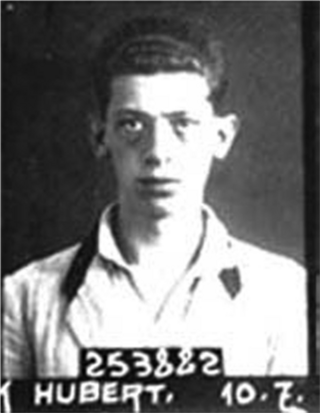Hofrat Dr. Hubert Jurasek

Personalia
Born:
Died:
Profession:
Persecution:
Imprisoned 09.07.1938 - 23.01.1939,
Resistance fighter (undetected)
Memberships
Curriculum Vitae
Hubert Jurasek was sent to the Christlich-Deutschen Turnverein [today: Sportunion] at a very early age. From here, he joined the "Katholisch-Deutschen Studentenbund" (KDSB), a branch organization of the Reichsbund der katholisch-deutschen Jugend Österreichs [today: Reichsbund für Jugend und Sport] in autumn 1930. While still at secondary school, Hubert Jurasek joined the student volunteer corps of the Austrian Young People (ÖJV) in the Josefstädter Fähnlein 'Khevenhüller' and worked here as a group leader. He attended the (humanistic) Piaristengymnasium in Vienna 8, where he graduated in spring 1938, and began studying law at the University of Vienna.
On the advice of his schoolmate Alfred Kostelecky, he becomes a member of the Marianische Kongregation (MK) in the Canisiuskirche in Vienna 9 with Fr Weiser, SJ. Here he met former comrades from the ÖJV, mostly middle school students from the "Student Free Corps" (Stufko). They formed illegal youth groups in various districts of Vienna under the leadership of Fred Ellinger. His monogram FE (chemical symbol for ferrum, iron) becomes the code name of this Gruppe Eisen in resistance. They produce pamphlets that are put in postboxes or placed in streetcars and telephone booths. Among other things, they reported on London radio broadcasts about the inhumane treatment of Jewish fellow citizens. They damage showcases of the Stürmer and engage in physical altercations with members of the Hitler Youth. As early as April 21, 1938, a former sub-leader of the ÖJV reported his comrades. After further reports, the first arrests were made by the Gestapo on May 20, 1938.
Hubert Jurasek was arrested on July 9, 1938 at an unauthorized MK summer camp at the Jesuit convent in Kalksburg with a total of 20 people for distributing anti-Nazi propaganda. Until July 20, 1938, he was first detained by the Gestapo on Morzinplatz and then in the Rossauer Lände police detention center. As an investigative prisoner of the People's Court, he was sent to the provincial court until January 20, 1939. At the end of the preliminary proceedings for 'treason against the German people', he was released on 23 January 1939 after six and a half months in prison by general decree of clemency.
Hubert Jurasek was declared unworthy of military service, study and employment. He tries to earn some extra money by doing odd jobs. To avoid being forcibly assigned to a Nazi organization for pre-military education, he volunteers for service with the Red Cross.
Throughout the war, the group of former members of the 'Neuland' association and the Breitenfeld parish youth group, which Hubert Jurasek joined after his release, stays together. In 1940, his ineligibility for military service was revoked by decree of the Führer. He was drafted into the German Wehrmacht on October 4, 1940 and was initially assigned to the heavy artillery as a radio operator, later enlisting as a medic and having to take part in the Russian campaign. He escaped the Stalingrad cauldron due to hepatitis. As a convalescent, he was first transferred to Stockerau and then to Tulln, where he served as a district elder with the site doctor.
Here he came into contact with the military resistance group Georg Zimmer-Lehmann and was able to help some people stay at home. In March 1945, he was deployed to defend the south of Vienna. At the end of the war, he was sent to the Mühlviertel and handed over to the Red Army as a prisoner of war by US troops after the armistice.
On his way into Russian captivity, he was only able to turn back as an Austrian in Iasi (Romania) and arrived back home on September 12, 1945. In order to earn a living, he joined the pharmaceutical salary fund as an employee on February 1, 1946, and at the same time resumed his law studies in Vienna, which he successfully completed in 1948 with a doctorate in law after taking the prescribed three state examinations and three viva voce examinations after six instead of eight semesters. In 1946, he joined the student fraternity Rudolfina.
During his studies, he joined the 'Free Austrian Student Union' (FÖSt), an organization close to the ÖVP. This organization delegates him to the Denazification Commission of the University of Vienna. In 1948, he joined the Federal Police. At the end of 1966, he left the service of the Vienna Federal Police Directorate as Senior Police Councillor and City Captain of Vienna's 8th district and was appointed Court Councillor of the Administrative Court, where he served until his retirement at the end of 1985, most recently as its Vice President.
He became an honorary member of the ÖVP-Kameradschaft der politisch Verfolgten und Bekenner für Österreich
Places
Residence:
Citations
- Krause, Peter/Reinelt, Herbert/Schmitt, Helmut (2020): Farbe tragen, Farbe bekennen. Katholische Korporierte in Widerstand und Verfolgung. Teil 2. Kuhl, Manfred (ÖVfStG, Wien), p. 149/150.
